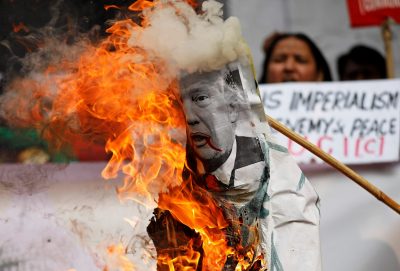Madeleine Albright, one of several scholar–statespersons the unique American spoils system used to produce as secretary of state, characterised the United States as ‘the indispensable power’. In relation to East Asia today, that description seems no longer salient. In this vein, perhaps thirty years from now we will look back on US President Donald Trump’s first official visit to East Asia as the moment when the United States abandoned a superpower role in Asia and grudgingly accepted that hegemonic power in the region would be shared with China.

In his obsession with dismantling the legacy of his predecessor, Trump withdrew the United States from the Trans-Pacific Partnership (TPP) days after taking office. The TPP was the economic pillar of the US ‘pivot’ to Asia announced by former president Barack Obama in 2009. It marked a continuity in US Asia policy back to 1945 in that it constituted the economic element of a threefold approach. The other two pillars were hard security (reflected in Obama’s pledge to move 60 per cent of US naval assets to the Pacific) as well as public diplomacy or soft power in promoting international public goods (such as democracy and human rights). It also meant providing an intellectually formidable State Department with adequate resources.
Trump’s trip to Asia in November 2017 demonstrated that his administration has largely abandoned, or at best severely weakened, two of the three pillars of this bipartisan foreign policy edifice. While in relation to North Korea there was a bellicose reaffirmation of the US commitment to playing sheriff, the multilateral economic and soft power dimensions were significantly downgraded. US proposals for bilateral trade deals were greeted with polite silence. Given the Trump administration’s drive to renegotiate the North American Free Trade Agreement and the US–Korea Free Trade Agreement as part of its ‘America first’ agenda, US credibility as a trustworthy trading partner has been sorely compromised.
As for US soft power, Trump’s ‘bromance’ with his Philippine counterpart President Rodrigo Duterte — shown through the former’s previous praise for the latter’s war on drugs, which has resulted in some 12,000 extra-judicial killings — has demonstrated a downgrading of human rights concerns. Secretary of State Rex Tillerson’s call in Naypidaw for an independent inquiry into what the UN has categorised as the ethnic cleansing of the Rohingya seemed an effort of diplomatic tokenism. Only under pressure from the US Congress did he later invoke the term ethnic cleansing and the possibility of sanctions against the Myanmar military (Tatmadaw).
By contrast, China potentially has the economic clout and political influence to impose a solution on the top ranks of the Tatmadaw. Tillerson’s Chinese counterpart Foreign Minister Wang Yi has proposed a three-phase plan for resolving the Rohingya crisis — a proposal that received support from both Bangladesh’s and Myanmar’s governments, with Aung San Suu Kyi visiting Beijing on 30 November.
In Manila there was the striking juxtaposition of the weakened US President vehemently defending a curious mix of bilateralism and isolationism against recently emboldened Chinese President Xi Jinping, who has been positioning his country as the champion of multilateralism and defender of the existing international order.
Rhetorically, for Trump, the term Asia Pacific has been replaced by ‘Indo-Pacific’: a revival of Japanese Prime Minister Shinzo Abe’s idea of a quadrilateral security arrangement involving Australia, India, Japan and the United States. If the United States cannot be a leader in a multilateralised East Asia, then perhaps it can consolidate three existing bilateral relations to be the first amongst equals.
But if we examine the practice of Trump’s administration, does the United States have the capacity to fulfil even this limited goal? Even further, does it have the desire to?
The breakdown of its Asia foreign policy status quo involves a combination of wilful negligence and discreet sabotage. Abandoning the TPP fell into the first category, while the hollowing out of the US State Department is a combination of both. Ten months after Trump’s inauguration, many senior positions in the State Department still have not been filled. Some one hundred senior diplomats have left and the threat of a one-third budget cut remains. The Trump administration’s gratuitous assault on multilateral institutions and agreements such as the WTO, UNESCO and the Paris Climate Change Agreement is being conducted in the same vein.
Yet while the United States has been seeking to weaken the international institutions it helped establish, China has been creating new international institutions to further its aims. An October 2014 China Monitor suggests some fourteen parallel and alternative multilateral structures with the potential to supplant existing ones. The most visible in Asia is the Asian Infrastructure Investment Bank. At what point a parallel institution supplants an existing one — if that is the objective of the Chinese leadership — is debatable. Still, in terms of articulating a long-term vision, China’s Belt and Road dwarfs anything that Trump seems capable of offering.
The question is whether this new emerging order will involve ‘multilateralism with Chinese characteristics’. Much will depend on whether other powers, notably the European Union, can compensate for the US vacuum to preserve and promote a liberal multipolar international environment.
David Camroux is Senior Research Associate at the Centre for International Studies (CERI), Sciences Po, Paris and Professorial Fellow at the Vietnam National University (USSH), Hanoi.
No comments:
Post a Comment